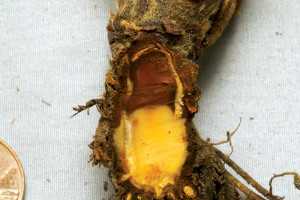Strawberry Growers Face Mounting Fumigation Challenges
Starting in 2005, growers in the Golden State were noticing an unusual collapse of strawberry plants. What caused the problem? The answer: two diseases — the soilborne fungi Macrophomina phaseolina, causing charcoal rot, and Fusarium oxysporum, causing Fusarium wilt.
This problem occurred not long after some growers began moving away from the fumigant methyl bromide. These strawberry producers understood where the industry was headed and knew they would eventually have to farm without methyl bromide, explains Steve Koike, a University of California Cooperative Extension plant pathologist with Monterey County. As these strawberry growers were among the first to farm without this fumigant, they also were some of the first ones to get these diseases, he adds.
The Same Symptoms
Complicating things, the Fusarium wilt and charcoal rot pathogens present identical symptoms, so diagnosing in the field is not an option. To avoid a misdiagnosis, Koike encourages growers to send samples to their local Extension office.
What are the symptoms to be on the lookout for? Plants afflicted with either of these pathogens will have wilted foliage, dead older leaves (younger leaves often remain alive), and plants will be stunted.

If pathogen levels are high, both Fusarium wilt and charcoal rot can cause severe losses for strawberry growers.
“Those in the pathology world anticipated this type of problem once growers got away from such a powerful tool as the combination of methyl bromide and pic (chloropicrin),” Koike says. “Now, all the major strawberry areas in California have both pathogens. We are quite alarmed.”
If these two diseases can’t be managed, that will have a huge impact on profitability and how the crop can be grown in California, he continues. “The change in pest management practices or the lack of availability of necessary tools translates into a biologically important development. In this case, it is two new diseases. Throughout California, most of these outbreaks are associated with the changing fumigation practices.”
Inadequate Application
In addition to no longer using methyl bromide, many strawberry growers are not applying the currently available fumigant materials to the entire field.
According to Koike and other researchers, growers are bedding up first and then applying a fumigant to beds — and only to beds — in part to reduce cost. The bottom line is growers are only treating roughly half of the acreage using this approach.
“This is a questionable practice from a disease management standpoint,” he says. “If you fumigate half the ground, half the ground will still have the fungus and growers will have problems. So it is not just the chemical, it is also how the fumigants are being applied that is a problem.”
Wanted: Resistant Varieties
When there are changes in production practices, such as the ones described here, that brings plant breeding into the mix, says Koike. For the important soilborne issues for most crops, the best way to get around it is to use resistant or tolerant varieties. Right now, however, there are no strawberry varieties available that exhibit the resistance needed.
“We do have some varieties that are little more tolerant to Macrophomina, and we have some other varieties that are a little more tolerant to Fusarium, but no variety is tolerant to both diseases,” Koike says. “Even if there were tolerant varieties, if conditions are favorable for the disease or the fungus population is high, the plants will eventually succumb to the disease and die. They may live longer, but eventually they will collapse.”
Options For Growers
Although strawberry growers don’t have varieties with high levels of resistance to both pathogens at their fingertips, they do have options, says Koike. In spite of the fact that there are no “drop-in” replacements for methyl bromide, growers have access to other fumigants.

Both Fusarium and Macrophomina colonize and kill the crown tissue of strawberries, resulting in collapse of the plant. Photo Credit: Steve Koike
He explains that these other materials kill Macrophomina and Fusarium but they are not as effective as the traditional methyl bromide/chloropicrin combination. Plus, with the bed fumigation practice where the entire field is not fumigated, growers are seeing a further drop in performance.
“So, first, we are trying to find other replacement pre-plant chemicals and fumigants that can do a better job of lowering pathogen levels in the soil before the strawberries are even transplanted,” he says. Secondly, the search is on for fungicides that could be applied to strawberry plants in place
in the fields, so the roots can be protected from Macrophomina or Fusarium infection.
“We are not very optimistic about this second approach because if you look at virtually all other soilborne disease systems, there are very few cases where you can apply a fungicide to a crop and get good control against a soilborne pathogen like these two species. It just doesn’t work that well.”
Koike adds that Fusarium diseases are usually specific to a crop. For example, Fusarium on celery is specific to celery. It is the same for strawberry. Fusarium wilt on strawberry is from the fungus Fusarium oxysporum f. sp. fragariae. This particular pathogen is host-specific to strawberries and does not impact other crops.
Macrophomina, however, is common on many other crops including soybean, corn, tomato, and pepper. “Initially the thought was that if Macrophomina builds up on strawberry, maybe the vegetable grower who rotates to pepper will have a big problem. Our preliminary investigation, however, has determined that this may not be the case,” explains Koike, indicating that Macrophomina on strawberry may be a distinct and different strain.
Plan Of Action
Right now, the game plan is to implement integrated approaches to reduce plants’ susceptibility to the two pathogens. The first thing to do, he says, is to be mindful of sanitation, especially when it comes to equipment.
“The movement of pathogens on equipment is likely a primary way that fields become contaminated,” says Koike. “Growers are now more careful about their equipment. If they have a ‘hot’ field with known Macrophomina problems, plow down the old strawberry plants at season’s end, then move to another field, that equipment may be carrying the pathogen. More and more growers are washing off equipment before going to a clean field. That is a very important and appropriate IPM measure.”
The second integrated approach is crop rotation. Growers are doing rotations since it appears the vegetable crops on the West Coast are not susceptible to these new strawberry pathogens, he says. “In fact, strawberry growers are rotating with vegetable growers and trying to get away from these infested fields and not build up the fungus,” he adds.










